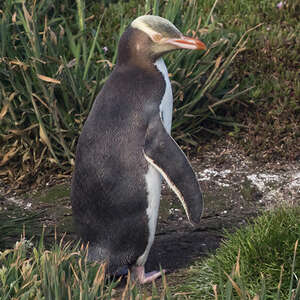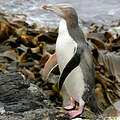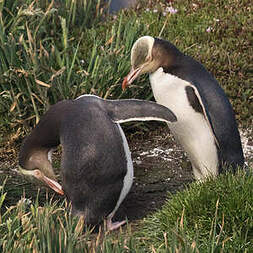Yellow-eyed Penguin
Megadyptes antipodes - Manchot antipode
Identification
The Yellow-eyed Penguin is the largest of the penguins breeding in New Zealand. From afar, it appears bicoloured, dark grey on top and white underneath. The head of the adult is brown, darker on the nape. The crown is blackish with a distinct band of pale yellow feathers stretching from one eye to the other, a characteristic of the species. The dark face is clearly striped with pale yellow. The bill, coloured in pale pink and carotene red, is around twice as long as high. The yellow eyes are surrounded by a zone of pink to red bare skin. The upper parts, from nape to tail tip, are slate grey. The lower parts, from throat to undertail coverts and legs, are white. Similarly to the body, the wings are grey on top and white underneath. The feet are pink. The sexes are alike, with the male being merely larger than the female. The juvenile has a duller plumage, grey eyes, and less vividly coloured bare parts.
Subspecific information monotypic species
Foreign names
- Manchot antipode,
- Pingüino ojigualdo,
- pinguim-de-olho-amarelo,
- Gelbaugenpinguin,
- sárgaszemű pingvin,
- Geeloogpinguïn,
- Pinguino occhigialli,
- gulögd pingvin,
- Guløyepingvin,
- tučniak žltooký,
- tučňák žlutooký,
- Guløjet Pingvin,
- keltasilmäpingviini,
- pingüí d'ulls grocs,
- pingwin żółtooki,
- Великолепный пингвин,
- キンメペンギン,
- 黄眼企鹅,
- gulögd pingvin,
- 黃眼企鵝,
Voice song and call
Habitat
The habitat is both marine and terrestrial. Like all members of the family, it feeds in the sea and reproduces on land.
The Yellow-eyed Penguin mainly nests in dense and tall vegetation (woodlands and scrub) covering the slopes or the top of coastal cliffs or else small valleys that cut into the coast. It can also nest in less enclosed places, overgrown lawns, windbreaks of planted exotic trees...
Behaviour character trait
Yellow-eyed Penguins are sedentary adults that frequent the coasts near breeding sites during all the year. From May to August, they are out at sea during the day and return to land every night, gathering to preen and rest, which is their form of socialization. The average lifespan of a Yellow-eyed Penguin is 8 years, with birds in the wild reaching up to 25 years. Males are reported to live up to twice as long as females in the wild.
Dietfeeding habits
Yellow-eyed Penguins feed on the continental shelf, between 2 and 25 km offshore, diving an average of 40 meters to hunt, though they can reach depths of over 100 m. The diet varies depending on location and date, but is very varied. A study on South Island based on 198 stomach contents revealed a diversity of 46 species of prey, mostly fish less than 25 cm long (sprat, red cod, opalfish, ahuru, slimy mackerel, blue cod...), the rest being made up of pelagic cephalopods and crustaceans.
Reproduction nesting
The breeding season stretches from August to March for 28 weeks. Pairs can be seen together on the breeding grounds as early as July.
The pairs are solitary or form loose colonies. Penguins choose sites for nesting that are vegetated and dense enough to hide the nest. The nest is a shallow depression made of twigs, grass, and leaves built by both adults. The average laying date is September 24th on the Otago Peninsula, but is later in breeding sites further south. Two eggs are laid at 3-5 day intervals. Incubation starts after the second egg has been laid and lasts 40-50 days, carried out by both partners. Hatching usually takes place in November.The raising of chicks takes place in two phases, the guard phase when chicks are constantly incubated and the post-guard phase when they are left alone in the nest during the day. In this species, young birds do not gather into collective broods. Emancipation takes place from February to March and even April when the birds are at this point nearly 4 months old. Around 50% of surviving juveniles will return to reproduce in their birthplace once they reach maturity at the age of 2-5.
The average breeding success is approximately one juvenile per breeding pair. The breeders of South Island often seem to come from prosperous breeding areas in the south that serve as a population reservoir, thus compensating for the low population in the north.
Geographic range
The Yellow-eyed Penguin is endemic to New Zealand. It can be found on the south-east coast of South Island, on Stewart Island and the adjacent islands, and in the subantarctic on the Auckland Islands and Campbell Islands. On the mainland, they breed in four distinct regions: the Catlins, the Otago Peninsula, North Otago, and the Banks Peninsula. The population is estimated to be around 1,700 breeding pairs, the majority being on the Auckland and Campbell Islands. South Island hosts more than 600 pairs, and there are about 180 on Rakiura/Stewart Island. On Stewart Island, Yellow-eyed Penguins breed along the north-east and east shores and on several offshore islands. Straggling birds have reached North Island as far as the Bay of Plenty, the Chatham Islands, and the Snares Islands.
The subantarctic and mainland New Zealand populations of the Yellow-eyed Penguin are genetically distinct.
Threats - protection
IUCN conservation status
concern
in the Wild
threatened
evaluated
The Yellow-eyed Penguin is the only existing member of the Megadyptes genus. It is the rarest penguin in the world. The species is currently in danger (IUCN Conservation Status - EN) and is considered threatened by the (DOC) Department Of Conservation.
Up until the mid second millennium, the Yellow-eyed Penguins were confined to the Auckland and Campbell Islands, while the continent was occupied by the Waitaha Penguins. A smaller form (the Richdale M. antipodes richdalei Penguin) lived on the Chatham Islands. It is believed the Waitaha and Richdale Penguins were hunted to extinction. The disappearance of the Waitaha Penguin allowed the Yellow-eyed Penguin to colonize the South Island late, facilitated by the disappearance of large marine mammals brought on by humans.
On land, habitat loss and fragmentation, predation, disease, human disturbances, thermal stress and hypothermia are reducing reproductive success.
Predation of chicks by introduced land mammals, hedgehogs, ferrets and ermines, is certainly the most important negative factor. The adults are not afraid of exogenous terrestrial predators, with the exception of dogs. The Yellow-eyed Penguin is also sensitive to human disturbances. Disruption by tourists results in reduced reproductive success. A lower chick weight at emancipation decreases the survival rate in the first year. When at sea, they are preyed on by sharks, barracuda and New Zealand Fur Seals.
Adults and chicks perish periodically from disease. In 1990, there was a large mortality of adults, and in more recent breeding seasons, chicks from mainland sites have been affected by a disease described as pharyngo-cutaneous stomatitis.Nothing indicates that industrial or recreational fishing directly reduces prey availability for Yellow-eyed Penguins, however they can be trapped in coastal fixed nets. There can also be a marked inter-annual variation in the resource. Years of scarcity are marked by reduced breeding attempts, slow chick growth, higher mortality in chicks before fledging, lower weight of juveniles, and lower survival of juveniles and adults.
Protection and habitat restoration, including control of predators, is managed by the Department of Conservation (DOC), the Yellow-eyed Penguin Trust, as well as by private landholders. There is regulated seasonal tourist presence in Yellow-eyed Penguin nesting areas on Enderby Island, in the Auckland Islands group, with adapted signage, as well as commercial nature tourism in private lands and reserves administered by the DOC.
Under DOC authority, privately funded rehabilitation centres serve as collection points for sick, injured or orphaned penguins. They also act as care and monitoring centres for managing epidemic periods.
Sources of information
- IOC World Bird List (v15.1), Gill, F and D Donsker (Eds). 2025-12-07.
- HBW Alive,
- xeno-canto, Sharing bird sounds from around the world,
Other sources of interest
 Specification sheet created on
30/07/2023 by Yann Cambon
Specification sheet created on
30/07/2023 by Yann CambonTranslation by AI Oiseaux.net
© 1996-2025 Oiseaux.net
- Accipitriformes
- Aegotheliformes
- Anseriformes
- Apodiformes
- Apterygiformes
- Bucerotiformes
- Caprimulgiformes
- Cariamiformes
- Casuariiformes
- Charadriiformes
- Ciconiiformes
- Coliiformes
- Columbiformes
- Coraciiformes
- Cuculiformes
- Eurypygiformes
- Falconiformes
- Galliformes
- Gaviiformes
- Gruiformes
- Leptosomiformes
- Mesitornithiformes
- Musophagiformes
- Nyctibiiformes
- Opisthocomiformes
- Otidiformes
- Passeriformes
- Pelecaniformes
- Phaethontiformes
- Phoenicopteriformes
- Piciformes
- Podargiformes
- Podicipediformes
- Procellariiformes
- Psittaciformes
- Pterocliformes
- Rheiformes
- Sphenisciformes
- Steatornithiformes
- Strigiformes
- Struthioniformes
- Suliformes
- Tinamiformes
- Trogoniformes






























